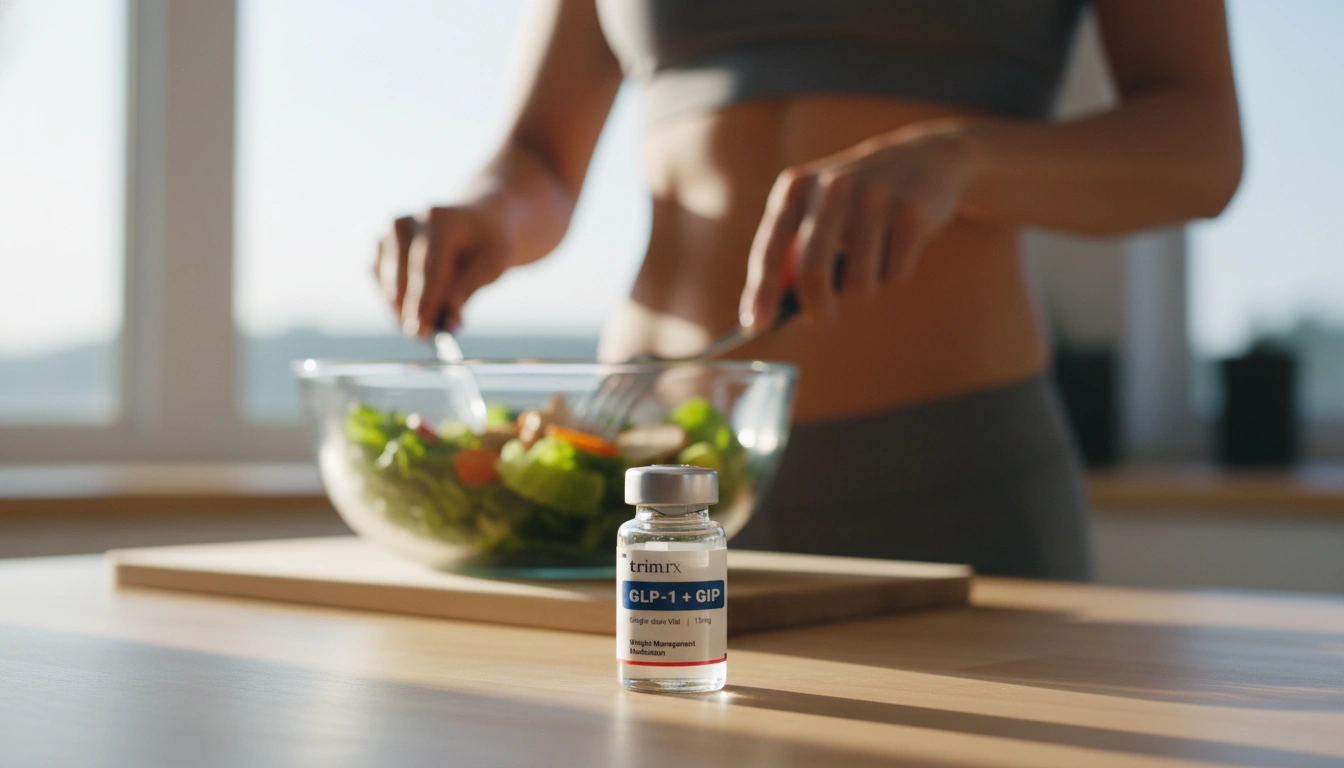Boosting Your GLP-1 Levels Naturally: A Complete Guide

Introduction
Did you know that our bodies produce a powerful hormone called GLP-1 that plays a crucial role in appetite regulation and blood sugar control? In recent years, this hormone has gained attention thanks to the rise of GLP-1 medications like Ozempic and Wegovy, which have transformed the lives of many struggling with weight management and metabolic disorders. However, the good news is that we can also boost our GLP-1 levels through natural means, such as diet and lifestyle changes.
Understanding GLP-1 and its significance in our metabolic health is more relevant than ever, as obesity and type 2 diabetes continue to rise globally. Thus, we invite you to explore how to increase your GLP-1 naturally and the lifestyle adjustments that can support this goal. By the end of this post, you will gain insight into effective dietary choices, exercise routines, and other strategies to enhance GLP-1 production in your body.
In this blog, we will delve into:
- The role of GLP-1 in the body
- Dietary approaches to stimulate GLP-1 production
- The impact of exercise on GLP-1 levels
- The myths and facts surrounding GLP-1 supplementation
- Practical tips for integrating these strategies into your life
Let’s embark on this journey toward understanding how to naturally increase GLP-1 levels and foster a healthier lifestyle.
Understanding GLP-1: A Key Player in Metabolism
GLP-1, or glucagon-like peptide-1, is an incretin hormone produced in the intestines. It is released after eating and plays a vital role in regulating glucose metabolism. GLP-1 stimulates insulin secretion, which helps lower blood sugar levels, and inhibits glucagon release, a hormone that increases blood sugar. Additionally, GLP-1 slows gastric emptying, promoting a sense of fullness and reducing hunger.
Research indicates that individuals with obesity may have a diminished GLP-1 response after meals, which can contribute to overeating and weight gain. By understanding the mechanisms behind GLP-1, we can appreciate how enhancing its levels can support weight management and metabolic health.
The Importance of GLP-1 in Weight Management
Studies have shown that higher levels of GLP-1 can lead to reduced appetite and increased satiety, making it easier to maintain a healthy weight. Additionally, GLP-1 has been linked to improved insulin sensitivity and glycemic control, which are crucial for preventing type 2 diabetes and other metabolic disorders.
With the rise of GLP-1 medications, understanding how to naturally increase this hormone in our bodies becomes even more vital. The following sections will explore dietary choices, physical activity, and other lifestyle factors that can promote GLP-1 production.
Dietary Approaches to Boost GLP-1
The foods we consume significantly influence our GLP-1 levels. Certain nutrients have been shown to stimulate the release of this hormone, and incorporating these foods into our diet can be a game changer for those looking to manage their weight or improve their metabolic health.
1. High-Fiber Foods
Fiber is a powerhouse when it comes to promoting GLP-1 secretion. Foods rich in fiber, such as whole grains, fruits, vegetables, and legumes, slow down digestion and promote a gradual release of glucose into the bloodstream. This process activates GLP-1 release, leading to enhanced satiety.
- Whole Grains: Oats, barley, and quinoa are excellent sources of soluble fiber. A study found that consuming oats can stimulate GLP-1 release and help control appetite.
- Fruits and Vegetables: Foods like apples, pears, broccoli, and carrots are high in fiber and vitamins. They not only contribute to GLP-1 secretion but also provide essential nutrients for overall health.
2. Protein-Rich Foods
Protein has a significant impact on GLP-1 levels. Consuming adequate protein can enhance feelings of fullness and promote GLP-1 secretion.
- Eggs: A rich source of protein and healthy fats, eggs have been shown to improve GLP-1 levels. In one study, participants who consumed eggs for breakfast reported lower blood glucose levels and reduced hunger compared to those who had a bagel-based breakfast.
- Lean Meats and Fish: Incorporating lean sources of protein such as chicken, turkey, fish, and plant-based options like tofu can also support GLP-1 production.
3. Healthy Fats
Not all fats are created equal. Healthy fats, particularly monounsaturated fats, can positively influence GLP-1 levels.
- Avocados: Packed with fiber and healthy fats, avocados have been associated with increased GLP-1 secretion. Studies show that consuming avocados can lead to enhanced appetite regulation.
- Nuts: Almonds, walnuts, and pistachios are excellent sources of healthy fats and fiber. Including these in your diet can promote satiety and contribute to GLP-1 release.
4. Fermented Foods
Fermented foods support gut health and can influence GLP-1 levels through their impact on gut microbiota.
- Yogurt and Kefir: These probiotic-rich foods can support a healthy gut environment and have been linked to increased GLP-1 secretion.
- Sauerkraut and Kimchi: Fermented vegetables are also great additions to your diet that can promote gut health and enhance GLP-1 production.
5. Spices and Herbs
Certain spices and herbs may also have a role in boosting GLP-1 levels.
- Cinnamon: This common spice has been shown to enhance insulin sensitivity and may support GLP-1 release.
- Turmeric: Known for its anti-inflammatory properties, turmeric may also have a positive effect on GLP-1.
Summary of Dietary Strategies
In summary, focusing on a balanced diet rich in high-fiber foods, lean proteins, healthy fats, and fermented products can significantly help increase GLP-1 levels naturally. By making conscious dietary choices, we can promote better appetite regulation and metabolic health.
The Role of Exercise in GLP-1 Production
Physical activity is another critical factor that influences GLP-1 levels. Regular exercise has been shown to enhance insulin sensitivity and improve overall metabolic health, which in turn can lead to increased GLP-1 secretion.
1. Types of Exercise
- Aerobic Exercise: Engaging in moderate-intensity aerobic activities—such as brisk walking, cycling, or swimming—can stimulate GLP-1 secretion. Aim for at least 150 minutes of aerobic exercise per week.
- Resistance Training: Incorporating strength training exercises can also boost GLP-1 levels. Resistance training enhances muscle mass and metabolism, contributing to better insulin sensitivity.
2. Consistency is Key
While a single exercise session can lead to short-term increases in GLP-1, long-term consistency is crucial for maximizing its benefits. Establishing a regular workout routine can help maintain elevated GLP-1 levels and support your weight management goals.
Summary of Exercise Benefits
Incorporating both aerobic and resistance training into your weekly routine can significantly enhance GLP-1 secretion, leading to better appetite control and improved metabolic health.
Myths and Facts About GLP-1 Supplements
As the popularity of GLP-1 medications rises, so does the interest in natural supplements that claim to boost GLP-1 levels. However, it’s essential to differentiate between facts and myths surrounding these products.
Myth 1: Supplements Can Replace GLP-1 Medications
While some supplements are marketed as “natural GLP-1 boosters,” they do not provide the same potent effects as prescription medications like semaglutide or tirzepatide. These medications are specifically designed to mimic the action of GLP-1 in the body and have undergone rigorous testing for safety and efficacy.
Myth 2: All Supplements Are Safe and Effective
Unlike prescription medications, dietary supplements are not uniformly regulated by the FDA. Consequently, their safety and efficacy can vary widely. Some may be backed by preliminary research, while others may lack substantial evidence.
Fact: Some Natural Substances May Support GLP-1 Release
Certain natural compounds, such as berberine, cinnamon, and curcumin, have shown potential in promoting GLP-1 secretion. However, the extent of their effects is not on par with prescription GLP-1 medications. If considering supplements, it’s crucial to consult with a healthcare provider before starting any new regimen.
Summary of Supplement Considerations
While some supplements may support GLP-1 release, they should not be viewed as replacements for medical treatments or as guaranteed solutions. Instead, focusing on natural dietary and lifestyle changes can effectively enhance GLP-1 levels.
Practical Tips for Increasing GLP-1 Naturally
Now that we’ve explored the various ways to increase GLP-1 levels naturally, here are some practical tips to help you integrate these strategies into your life:
- Plan Balanced Meals: Aim to include high-fiber foods, lean proteins, and healthy fats in each meal. Consider meal prepping to ensure you have nutritious options readily available.
- Stay Active: Incorporate both aerobic and resistance training into your weekly routine. Find activities you enjoy to make exercise more sustainable.
- Stay Hydrated: Drinking adequate water throughout the day can support overall metabolic health and digestion.
- Mindful Eating: Practice mindful eating by slowing down during meals, savoring each bite, and paying attention to hunger cues. This can enhance satiety and promote a better relationship with food.
- Consult a Professional: If you have specific health concerns or are considering supplements, consult a healthcare provider or a registered dietitian for personalized guidance.
By adopting these strategies, we can work together to enhance our GLP-1 levels naturally, leading to improved metabolic health and a healthier lifestyle.
Conclusion
Increasing your GLP-1 levels naturally is achievable through mindful dietary choices, regular exercise, and an understanding of how these factors influence our metabolism. By focusing on high-fiber foods, lean proteins, healthy fats, and maintaining an active lifestyle, we can promote better appetite regulation and metabolic health.
As we navigate our unique health journeys, we at TrimRx are committed to offering personalized, medically supervised weight loss solutions that respect our clients’ individual needs. If you’re looking to explore tailored options for your weight management journey, we encourage you to take our free assessment quiz to see if you qualify for our prescription weight loss medications. Together, we can embrace a healthier lifestyle and achieve sustainable weight loss.
FAQ
What is GLP-1 and why is it important?
GLP-1 is a hormone produced in the intestines that plays a crucial role in regulating blood sugar levels and appetite. It stimulates insulin secretion, inhibits glucagon release, and slows gastric emptying, promoting a sense of fullness.
How can I naturally increase my GLP-1 levels?
You can increase your GLP-1 levels by consuming a diet rich in high-fiber foods, lean proteins, and healthy fats. Regular physical activity, particularly aerobic and resistance training, also enhances GLP-1 secretion.
Are there any supplements that can boost GLP-1 levels?
Some natural substances, such as berberine and cinnamon, may support GLP-1 release. However, they should not be viewed as replacements for prescription medications, and it’s essential to consult a healthcare provider before starting any new supplement.
How does exercise affect GLP-1 levels?
Regular exercise, especially aerobic and resistance training, can enhance GLP-1 secretion and improve overall metabolic health. Aim for at least 150 minutes of moderate-intensity exercise each week.
Can I rely on GLP-1 supplements instead of medication?
GLP-1 supplements may have some benefits, but they do not provide the same potent effects as prescription GLP-1 medications. Always consult with a healthcare provider to determine the best approach for your health needs.

Transforming Lives, One Step at a Time
Keep reading
7 Tips for Sticking to GLP-1 Injection Schedules
Seven practical strategies to keep weekly GLP‑1 injections on schedule—pick a routine day, set reminders, manage side effects, rotate sites, and avoid missed doses.
Custom GLP-1 Dosing for Kidney Disease
Personalized GLP-1 dosing for CKD patients with monitoring, dehydration and hypoglycemia risk mitigation, and guidance across all kidney disease stages.
Semaglutide vs Tirzepatide: Approved Uses
Two leading diabetes and weight-loss drugs differ in FDA-approved benefits — one adds heart, kidney and liver protection; the other treats obstructive sleep apnea.



